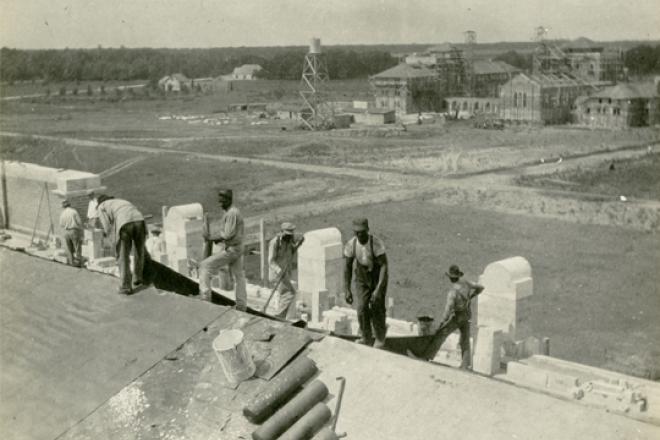
A Ciudad Victoria street filled with families taking a stroll. Photographs by John Pluecker.
John Pluecker, a writer and interpreter who contributes regularly to Cite and OffCite, sends this postcard from Ciudad Victoria, the capital city of the northernmost Mexican border state on the Gulf Coast, just south of the Rio Grande Valley.
I say: Tamaulipas, Mexico. And you're probably thinking violence, drug war, danger, State Department travel warnings.
You're probably not thinking thousands of families, children, roller-bladers and dog-walkers strolling down a large avenue on a Sunday evening. A sea of people filling the four-lane street and the wide tree-shaded median. Flashing Christmas lights and cheesy illuminated angels. Karaoke singing in the street, indie rock bands on a tiny stage in front of the main cultural institute, an ampitheatre with b-boys and b-girls in Santa costumes, a stage full of flashing lights and artificial smoke dedicated to local grupero bands and hundreds of people dancing cheek to cheek in a traffic esplanade.
Yet both images are real.

Last week, I drove down to my local East End bus terminal in Houston and got on a spacious Omnibus to Tamaulipas's state capital, Ciudad Victoria (where I am now as I write this) about three hours south of the border at the edge of the verdant slopes of the Sierra Madre Oriental.
As you probably have heard, the city and the state as a whole have been devastated by the Drug War and its attendant violence: car bombs, grenade attacks, mass killings. The news about Tamaulipas in the U.S. is all bad all the time. And not for nothing. The situation is grim.
And yet as my friend, writer Marco Antonio Huerta says, there are more than three million people in the state who go on with their lives every day the best they can. Carving out little spaces of calm. Making do. Despite it all.
Maybe I shouldn't be surprised at people's resilience, maybe I should expect it by now after all these years, but with the media reports in Mexico and in the U.S. being as horrific as they are, it gives the impression that the state died a long time ago. I'm happy to report that at least one night a week, this city gets together to refuse to die.
At the height of the violence in mid-2011, Ciudad Victoria began Libre 17 (named after the street that closes down each week), an event on Sunday evenings from 5-10 pm during which they close off two miles of an avenue between a big park and a stadium. An outright challenge to fear and paranoia caused by the war and its massively high levels of violence. A way to rebuild social fabric, frayed and torn after years of madness.
I was a little shocked to find so many people in public at night: dancing, walking, enjoying the cool December air. This is an active war zone after all. I was also heartened once again by Mexican resiliency: at just how beautiful making do can be.
Could this be an example for Texas cities? Even in the midst of this awful war, the people of Ciudad Victoria can teach us a lot about building functional public spaces, public rituals, building community.
I wonder why Houston can't close Westheimer (between Shepherd and Bagby) or McKinney downtown (between City Hall and Discovery Green) or Harrisburg or Hillcroft or some other big street and just let pedestrians take over once a week. Let a thousand Sunday night walks bloom.
Just a simple avenue for families to walk a stretch in the company of others. A boost for local businesses. A reason to get out on a Sunday night no matter the time of year. A space for performance artists and musicians and writers to interact directly with a wider public. Who knows, it might even attract a cross-racial, cross-class slice of the city. But I wonder if it could stay simple; everything becomes so commercial so quickly in Houston: corporate sponsorships, admission fees. It would be hard to explain the idea to people. Just walking. Just a closed road.

Dance, dance, revolution! Dance, b-girl santa, dance!
Of course, there are a million reasons not to do it; I can already hear the cries. Trash! Parking! Disorder! Danger! But there are so many reasons to do it: we have so few public spaces, so few non-commercial spaces to gather. We have our own work to do to share space, to build a social fabric. To turn streets into pedestrian spaces, not just channels for cars. Normally, we never even get to look at each other. And we should be looking.
Cite has had a long-term interest in urban issues in the Mexican states along Texas's border. A wonderful issue in Fall 2001 (52) edited by Rafael Longoria looked specifically at Monterrey and the culture of northeastern Mexico. In that issue, Cite looked at the lessons we could learn from experiences of urbanism in the third-largest city in Mexico, just a few hours south of the border. It seems we can continue to learn from our neighbors.
Maybe later after a few months of success, we could invite some of those b-boys and b-girls, the grupero bands and indie rock groups, local poets and roller-bladers to come up and show us how it's done. How to make do even under the worst of circumstances.










